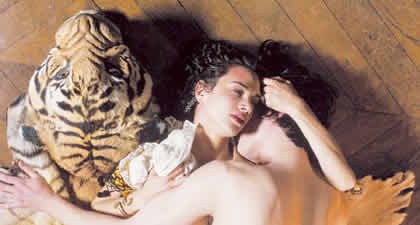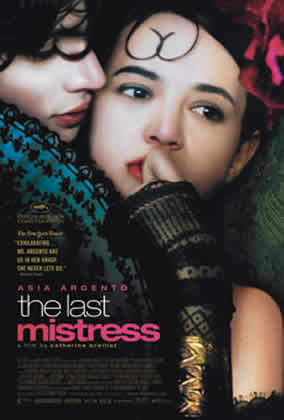Catherine Breillat is a Paris based filmmaker and writer who became famous for her distinctively personal films on sexuality, gender trouble and sibling rivalry. Accused of being a ‘porno auteuriste’, Breillat allowed for an unbiased view of sexuality and extended the language of mainstream movies. She is also a best-selling novelist and wrote her first novel, L’Homme Facile, at the age of 17. Breillat acted in Bernardo Bertolucci’s Last Tango in Paris (1982) and wrote the screenplay for Maurice Pialat’s movie Police (1984). Since her first film Une vraie jeune filles (1975, not released before 2000), Breillat explored critically as well as innovatively the perceptions imposed on female sexuality, related family and coming of age issues. Major films: Virgin (36 Fillette), Perfect Love, Romance, Fat Girl, Sex is Comedy (from http://www.egs.edu/faculty/breillat.html )
THE LAST MISTRESS is a smoldering adaptation of Jules Barbey d’Aurevilly’s scandalous 19th-century novel. Set during the reign of “citizen king” Louis Philippe, it chronicles the surprising betrothal of the aristocratic, handsome Ryno de Marigny (newcomer Fu-ad Aît Aattou) to Hermangarde (Roxane Mesquida of FAT GIRL), a young, beautiful and virginal aristocrat. Lurking in the margins – and in the imaginations of high society’s gossip-hounds – is de Marigny’s older, tempestuous lover of ten years, the feral La Vellini (Argento). Described as, “a capricious flamenca who can outstare the sun,” La Vellini still burns for de Marigny, and she will not go quietly.
Ryno de Marigny (newcomer Fu-ad Aît Aattou) to Hermangarde (Roxane Mesquida of FAT GIRL), a young, beautiful and virginal aristocrat. Lurking in the margins – and in the imaginations of high society’s gossip-hounds – is de Marigny’s older, tempestuous lover of ten years, the feral La Vellini (Argento). Described as, “a capricious flamenca who can outstare the sun,” La Vellini still burns for de Marigny, and she will not go quietly.
Bijan Tehrani: No matter how diverse your films are they all have several aspects in common; they are very fresh, interesting, and new in their ideas and content. What I have noticed in this film is that you have similarities to Luis Buñuel, in the way that you look at life. Is this something that you are aware of?
Catherine Breillat: Yes, well, I wanted to become a cineaste when I was young. I saw a Luis Bunuel film when I was young. You are not always aware of the influence other people have on you; it’s other people who point out such influences. I am very highly influenced by painting, and have always seen myself as a painter.
BT: This is very obvious in your film, with the styles and the setup of each scene. It gives the feeling of painting. The whole film is like a canvass that you have painted your movie on. Is that something that you did intentionally?
CB: Yes, I am absolutely very aware of those elements. I am very conscious of how I play with light and dark, and finish out the diagonal and horizontal lines. I create each shot as a painting—but of course a painting that moves. After I made “Perfect Love”, Jean Luc Goddard, who saw the film, said that he liked it a great deal, and we had lunch. But he said afterward that the film wasn’t that extraordinary, and that there was a lot in it. I interrupted him, and said, yes, I take care of what is in the film; you take care of the exteriors, the framing of the film. It is true that Goddard is famous for the perfection of his framing. He is also a great painter. But I see myself working with both the emotion within interior of the frame and also the framing itself. If you are not dealing with all of those elements, you are not really creating cinema, or art. You need both the movement and the frame.
BT: In this film, what also seems intentionally done is the absence of camera movements. What I watched the film for the first time; I could see that most of the shots were still frames. This actually helps the viewer concentrate more on the characters in the film. Is a lack of camera movements typically your style? CB: Yes. I was absolutely fascinated by Fu’ad’s [Fu’ad Ait Aattou plays Ryno de Marginy in the film] face, and I was simply contemplating it in adoration on set. This led me to film in a way that I hadn’t shot before and also to use lenses that I hadn’t used before. I used lenses that weren’t so appropriate for Asia’s [Asia Argento plays Vellini] face, but were for Fu’ad’s. I used 150mm and 180mm lenses that I had never used before on anyone else’s face. His face is almost movement in itself, so you don’t need more movement. You are able to enter the face through the camera lens. (discontinuity she answers yes to the question that lack of camera movement is her typical filming style but then says she shot the film in a way she hadn’t ever before.)
CB: Yes. I was absolutely fascinated by Fu’ad’s [Fu’ad Ait Aattou plays Ryno de Marginy in the film] face, and I was simply contemplating it in adoration on set. This led me to film in a way that I hadn’t shot before and also to use lenses that I hadn’t used before. I used lenses that weren’t so appropriate for Asia’s [Asia Argento plays Vellini] face, but were for Fu’ad’s. I used 150mm and 180mm lenses that I had never used before on anyone else’s face. His face is almost movement in itself, so you don’t need more movement. You are able to enter the face through the camera lens. (discontinuity she answers yes to the question that lack of camera movement is her typical filming style but then says she shot the film in a way she hadn’t ever before.)
BT: You have faced complaints about sexual content in your films. Did you receive the same kind of comments from the film critics for this film as well?
CB: I don’t criticize weddings for their sexual content. I respect nature.
BT: In your films we see relationships from the female’s point of view. This point of view is presented well in your films. I think that is what bothers some people . What do you think?
. What do you think?
CB: Yes, that is probably the case. I think the other thing that disturbs them is the fact that my gaze is very precise and accurate, so the audience can’t say that this is fiction and just a story. People have to say, “It is us”. They are looking at a mirror and can’t avoid their own gaze.
BT: The casting of the film is very interesting. I could not think of any actors or actresses playing the parts other than those who were in the film. How did you go about casting this film?
CB: Well, you find actors such as Michael Londsdale and Yolande Moreau, who are highly respected and very experienced actors who have worked with me before. But then there is everyone else who is working here for the first time with me. Fu’ad, for example, never appeared in a film before. It is true that Roxane [Roxane Mesquida] has appeared in a number of my films, but I see her as being my actress, she belongs to me. Claude Sarraute, the other lady in the film, is eighty years old and appearing on camera for the first time. Before turning to film, Claude was a journalist for Le Monde. There are many people in the film who are appearing on the screen for the first time. I like possessing people. It is a way of working that I like very much. I have always done that.
BT: When I watch your film it is like watching reality. It is not even like watching a documentary; it is like a real scene happening in front of your eyes. How do you manage to get such real responses from your actors?
CB: When I am shooting a scene I always tell the actors that I don’t have the right to be present, and that even the cameras are out of place. I tell them that I am watching two people, and what I am filming is what transpires between the two people. I am constantly telling them that this is such an intimate moment that I don’t have the right to be there. It is out of this environment that the emotion and deep sense of reality are developed. When they are reading the script, I tell them that if they simply perform what is on the page, we would be seeing what we have seen before, what is expected. I tell my actors to surprise me, to do something different. Because otherwise they would be something that has been done before, and there is no interest in seeing that.
BT: Any new projects coming up?
CB: Right now I am working on casting a film for the RT television network. It will be a small budget film. It will be a reworking of an adaptation of the French fairy tale, “Blue Beard”. I think it will surprise people. I am also working on a project with Naomi Campbell. It will be a film about two criminal lovers. I have already done some screen tests with Naomi, and she is absolutely surprising. She is incredible.
